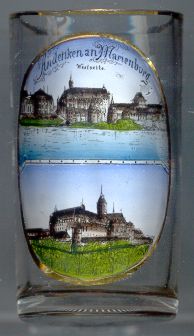

|
| POLSKA | POLAND |
| województwo: Pomorskie | voivodship: Pomerania |
| powiat: Malbork | county: Malbork |
 Malbork is situated at an elevation of 20 m on the river Nogat in northern Poland.
Malbork is situated at an elevation of 20 m on the river Nogat in northern Poland.
The famous  castle of the Teutonic Order [left] was founded by Master Konrad von Tienberg in 1274, and was named for the
patron of the order, the Virgin Mary. The northern wing with the church Sankt Marien and the chapter house were completed already in 1280,
the palace of the Grand Master followed in 1309. The whole castle was finally finished in 1328–1344.
Grand Master Siegfried von Feuchtwangen transferred the main seat of the order from Venice to Marienburg in 1309. Since then
the castle was the site of the grand chapters of the order and the site where the Grand Masters and the five Gebietiger of the order were elected.
The castle was successfully defended by Heinrich von Plauen against Prince Jagiello I of Lithuania (Wladislav II as King of Poland) in 1410.
Although it was again defended in 1454 the order had to impawn it in 1455 to its mercenaries who immediately sold it to the Polish King. The King took the Marienburg
in his possession on 7 June 1457 and Grand Master Ludwig von Erlichshausen, who had fled just one day before, took refuge in Königsberg
(now Kaliningrad). The town below the castle finally had to surrender in 1460. After the Second Peace of Thorn
(now Toruń) in 1466 town and castle became part of Poland. When the last Grand Master of the Teutonic Order, Albrecht II of Brandenburg-Ansbach, transformed the
castle of the Teutonic Order [left] was founded by Master Konrad von Tienberg in 1274, and was named for the
patron of the order, the Virgin Mary. The northern wing with the church Sankt Marien and the chapter house were completed already in 1280,
the palace of the Grand Master followed in 1309. The whole castle was finally finished in 1328–1344.
Grand Master Siegfried von Feuchtwangen transferred the main seat of the order from Venice to Marienburg in 1309. Since then
the castle was the site of the grand chapters of the order and the site where the Grand Masters and the five Gebietiger of the order were elected.
The castle was successfully defended by Heinrich von Plauen against Prince Jagiello I of Lithuania (Wladislav II as King of Poland) in 1410.
Although it was again defended in 1454 the order had to impawn it in 1455 to its mercenaries who immediately sold it to the Polish King. The King took the Marienburg
in his possession on 7 June 1457 and Grand Master Ludwig von Erlichshausen, who had fled just one day before, took refuge in Königsberg
(now Kaliningrad). The town below the castle finally had to surrender in 1460. After the Second Peace of Thorn
(now Toruń) in 1466 town and castle became part of Poland. When the last Grand Master of the Teutonic Order, Albrecht II of Brandenburg-Ansbach, transformed the
 countries of the order into a secular state (Duchy of Prussia with residence in Kaliningrad) in 1525, the Teutonic Master (Deutschmeister), from then on
Grand and Teutonic Master (Hoch- und Deutschmeister), took his residence in Mergentheim.
In 1626 and 1629 the castle was occupied by Sweden,
and was a trust of the Margraviate of Brandenburg until 1635. From 1656 until 1660 it was administered again by Sweden. Since 1737 the castle served
as military barracks. The building of the Jesuit convent was added in 1756–1767. After the 1st Partition of Poland in 1772 Marienburg became part of Prussia.
From 1819 until 1931 most parts of the old castle were restored. In 1945 about 80% of the town were destroyed and the castle suffered severe damages.
After World War II the Polish Communist regime decided to demolish the remaining parts of the old town.
The castle, however, was partly restored and became a museum in 1961. In 1997 it was listed as a World Cultural Heritage by the UNESCO
(see also list of other UNESCO heritage sites).
countries of the order into a secular state (Duchy of Prussia with residence in Kaliningrad) in 1525, the Teutonic Master (Deutschmeister), from then on
Grand and Teutonic Master (Hoch- und Deutschmeister), took his residence in Mergentheim.
In 1626 and 1629 the castle was occupied by Sweden,
and was a trust of the Margraviate of Brandenburg until 1635. From 1656 until 1660 it was administered again by Sweden. Since 1737 the castle served
as military barracks. The building of the Jesuit convent was added in 1756–1767. After the 1st Partition of Poland in 1772 Marienburg became part of Prussia.
From 1819 until 1931 most parts of the old castle were restored. In 1945 about 80% of the town were destroyed and the castle suffered severe damages.
After World War II the Polish Communist regime decided to demolish the remaining parts of the old town.
The castle, however, was partly restored and became a museum in 1961. In 1997 it was listed as a World Cultural Heritage by the UNESCO
(see also list of other UNESCO heritage sites).
![[scale]](lineal.jpg)